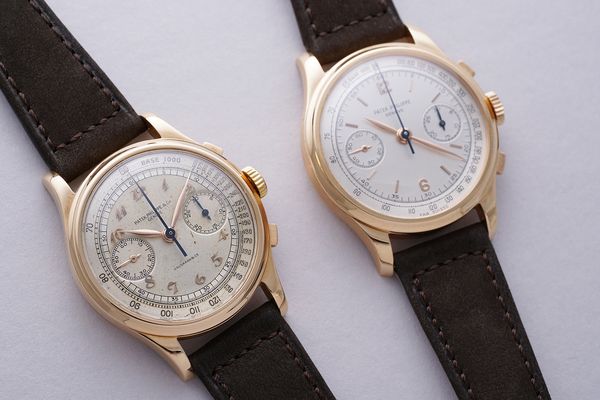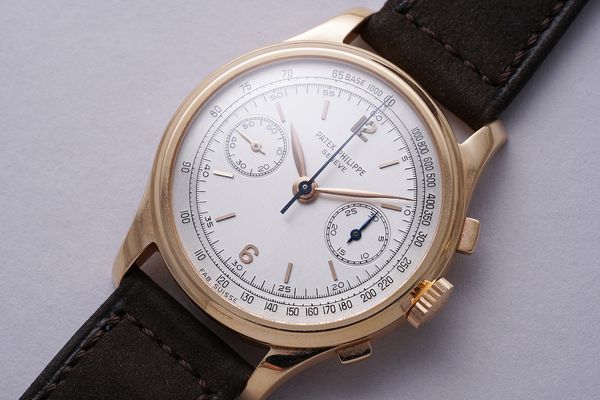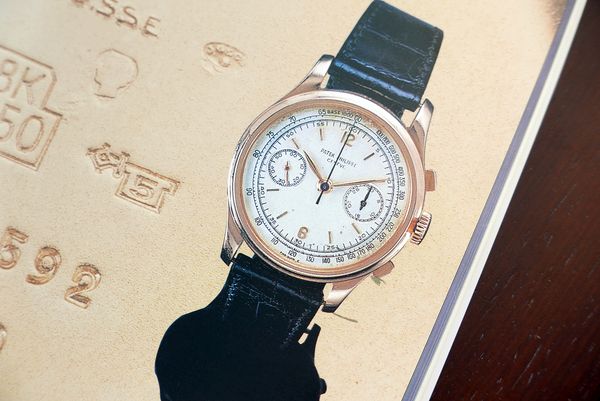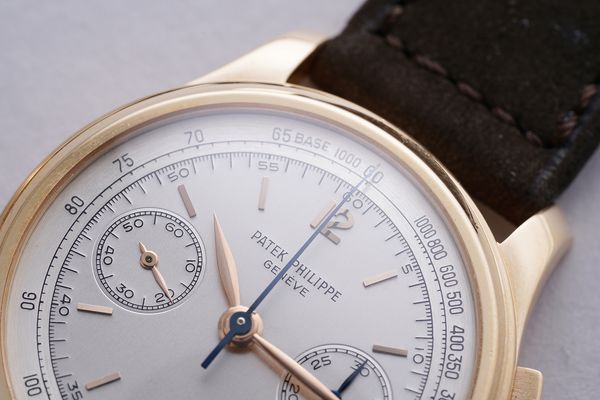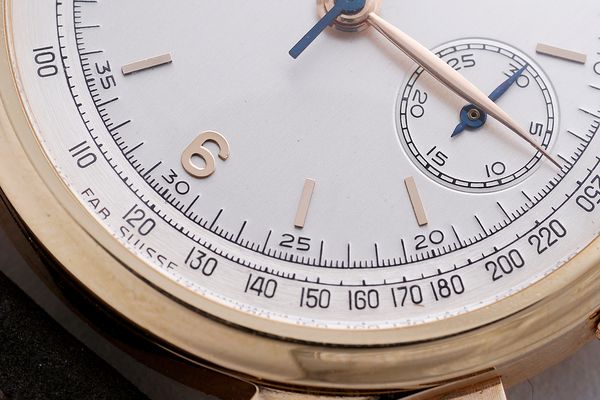- By Arthur Touchot
Introduction
Believe it or not, the two watches before you are roughly the same age. The one on the left is from 1949, while the one on the right — with the immaculate dial — is from 1956. They're both Patek Philippe reference 530 chronographs and they are both made in pink gold, which is a case metal we very rarely see. Despite these similarities, one of the watches has a low estimate double that of the other, and I bet I know what you're thinking. It's got to be the one with the perfect dial. Well, it isn't. Because that dial has been fully restored. We'll explain why that matters in the current market — and why that could change — after the jump.
The Reference 530
Patek Philippe is known for making many of the world's most beautiful and complicated watches, but it's very rarely mentioned as a chronograph maker despite making some of the earliest and finest wristwatch chronographs, including the reference 530.
A spectacular chronograph with a surprisingly large case measuring 36.5mm, the reference 530 was launched in 1937, just a few years after the manufacture's first chronograph reference, the ref. 130.
Both watches were powered by manual-winding calibres measuring 13 lignes, but the reference 530 was an important entry as it was the first watch to show the manufacture's readiness to revise the classic Patek Philippe Calatrava case.
In some ways, and even though most examples were made in gold, this was the manufacture's first steps into the field of sports watches. Increasing the case size of the chronograph made complete sense. This meant the scales printed on the dial — tachymeter or pulsometer scales for the most part — would be much more legible.
In fact, only in recent years would Patek Philippe produce larger manually-wound, two-register chronograph models styled after the reference 530, the current reference 5170 being the latest chapter. For these reasons, the reference 530 is revered for being not only one of the finest chronographs of the 20th century but as one of the few Patek Philippe chronographs from that century with dimensions that remain totally relevant 80 years after it was made.
Patek Philippe produced the reference 530 for almost 20 years, with various dial configurations making their way into yellow and pink gold cases, and in very rare instances, in stainless steel cases.
But despite a long production run, few pieces were actually produced. We currently know of only 15 pieces in rose gold, so to have two versions in pink gold in our offices at the very same time is pretty exceptional.
On the one hand, there's the 1949 model, with a wonderful Hausmann signed dial which has developed a charismatic patina around the Breguet numerals. The enamel signature is crisp, the comma and accent on the –e– of Genève are still present. It's never been touched, but it has unmistakably aged since it was made. In the car world, this watch's equivalent would be a barn find covered in dust.
On the other, there's the 1956 model, which is spotless. The two-tone dial, which is one of the watch's most striking feature, is like-new, and we're going to explain, in detail, how it got to be this way.
The Economics Of Watch Restoration
It's relatively easy and therefore tempting to bring an old watch back to life. Polishing the case will remove some of the dings it has accumulated over the years and make the watch shine like it did when it was made. Because of this, most vintage watches end up on a polishing wheel, but what most owners do not realize is that experienced collectors prefer instead to buy unpolished models that have never met the restorer's hands.
First, because most restorations aren't very good. Some are shockingly bad, actually. Polishing a watch can only be achieved by removing some of the case's metal, so the fundamental structure of a watch can change during its restoration. In rare cases, that could mean weakening already fragile areas such as the meeting points of the lugs and the case.
The same is true with dials. With hard enamel dials, a non-professional polishing of the basic plate can sometimes end up removing some of the enamel, impacting its definition. So, bad restorations not only hurt a perfectly lovely watch, they also literally remove some of its old-world charm. Of course, there's a simple solution to that problem which is to apply new paint, but that brings us to the fundamental problem with watch restorations. They are sometimes even regarded as being unethical.
Even the language used to discuss vintage presents this topic, not as a quality issue, but as a moral issue. Watches have become defined by their 'character.' Those which have been preserved in great condition are 'authentic' and 'pure.' Even the ones in objectively poor condition are known as 'honest' watches, which only encourages the thinking that watches that have been brought back to their original condition are somehow fraudulent.
What's interesting is that it's very different for cars.
The thought of getting a car back on the road after years of neglect is what motivates many car enthusiasts to purchase their first vintage car. Of course, there's a great deal of satisfaction to be found in repairing something broken. But above all, they do it for the fun. The process of repairing a car, which can be long, arduous and pretty expensive, is what they're after and it's what they remember long after the car has been repaired.
But restoring cars isn't just accepted, it's encouraged. There are literally thousands of books that will teach you how to turn an Ebay purchase into a concourse ready automobile, and petrol heads will spend years and invest serious money into top-notch restorations, even if that means using computer-aided design to produce new parts when they are no longer available.
I know guys who will happily purchase a rusty Porsche 911 and send it straight to their favorite mechanic, but who won't go near a watch that's been polished. Why? Because there's a market for restored cars—a very big one in fact—but it's simply not the same when it comes to restored watches.
Just take the results of RM Sotheby's auction in New York, held last December. Three out of the five highest achieving lots were vintage cars that had, at one point in their lives, received a full restoration, including the $17.8M Ferrari 250 GT California Spider which led the auction. The other two were a brand new, never-driven Bugatti Chiron and a four-year Ferrari LaFerrari with 53 miles on the counter. In other words, all of the vintage cars in the top five results had been restored, and the auction house made sure potential buyers were aware of it by calling attention to cars' 'high-quality restoration,' 'significant refreshing' and 'complete body-off restoration' in the catalogue entries.
These words were being used proudly to sell the cars, with records of the work done to back up the choices made by the professionals who restored them, including photographs from previous owners to show their original condition.
The results are often more tempered when it comes to restored watches. Watches that show signs of servicing just don't generate as much enthusiasm as the others in the room and that's why, for years now, specialists have been urging collectors who own imperfect watches to keep them that way. It is a fact that in the current market, a watch with a few scratches on the case and spotted dials is better left alone than perfectly restored.
But there's a new reality facing collectors, and it is this: The number of watches in mint condition is finite, and the competition for those watches is so fierce that many have been pushed out of this competition. Of course, collectors will continue to want those watches, and the question which they inevitably face is what is the value of a watch that has been restored with the level professionalism that has become customary in the car world.
I think there is, and quite a lot of it, actually.
The "Concourse Quality" Patek Philippe Ref. 530
The Patek Philippe Reference 530, as it appeared the last time it was sold at auction, in 1999
Here's what the pink gold reference 530 looked like the last time it was sold at auction.
One of the highlights of 1999 Sotheby's Geneva spring sale (it appeared on the cover of the auction house's catalogue), the watch, then estimated between CHF 120,000 and CHF140,0000, achieved a very strong final price (approximately CHF 180,000 inc. buyer's premium), because of its extreme rarity, and because it was one of the best examples of an unrestored and unpolished pink gold Patek Philippe reference 530 that had ever appeared on the market.
Now, the brownish marks that were so clearly visible in the catalogue images have completely vanished. And you might be surprised to learn that's completely intentional. The buyer of the watch, who has owned it since 1999, had the dial restored knowing the market’s scepticism when it comes to watches. So why did he do it? The answer has something to do with where the watch was sent.
Just like a car collector would, the owner of this reference 530 wanted his watch to be restored to an extraordinary level of authenticity, which meant leaving some of the dial alone and restoring only elements that were damaged. More importantly, the restoration should be done in the manner the watch was made, back in 1956, by Stern Frères.
"Because dials have been restored very poorly in the past, the reputation of this craft has ultimately suffered," said the owner of the watch. "What we've been missing is a creditable address with an irreproachable reputation."
"I had a difficult decision to make, and I thought about it for a very long time. But while I studied this question, I was lucky to meet former collaborators of Stern Frères who had themselves worked in the 1950s and 1960s on these types of dials."
"Together, we stripped down and analysed the fabrication process of this dial. We were able to refer back to records from Stern Frères. Knowing all of this, we visited their successors, the Cadraniers de Genève."
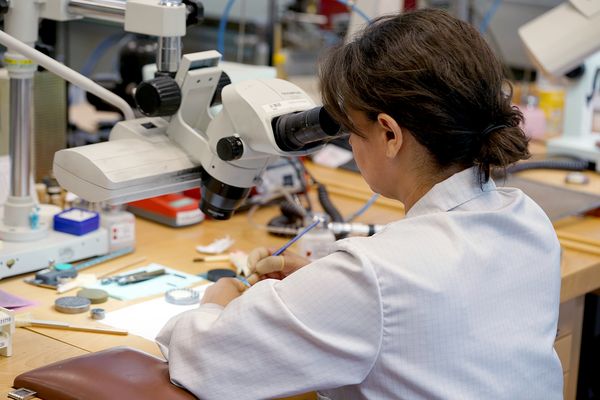
A dial maker from the Cadraniers de Genève. Approximately 25 artisans with different specialities work in this small structure outside Geneva.
Inaugurated in 2012, the Cadraniers de Genève is small workshop who produce high-end dials for François-Paul Journe and Vacheron Constantin, and who also restore pieces from many other haute horlogerie companies, using techniques and tools that have been passed on for generations. And because of their size and relatively small output, they are able to dedicate themselves fully to such important projects.
"It became clear that at every step of the restoration process the craftsmen involved were incredibly experienced. They knew how these dials were made, and had access to the original tools used to make them."
There was no more doubt in his mind, this watch could be restored the correct way. Still, he remained involved throughout the restoration process. He says he was in constant communication during the six months it took to restore the champlevé enamel dial, debating every decision made in the process.
"I told the Cadraniers to worry about the quality of the work, not its price," he said.
During a recent visit of the Cadraniers de Genève, I was able to learn more about this unique project, and indeed, I was told the collector's commitment was unmatched, even by watch manufactures. In their opinion, this was one of the finest restoration projects ever carried out, precisely because the collector knew what an authentic restoration required.
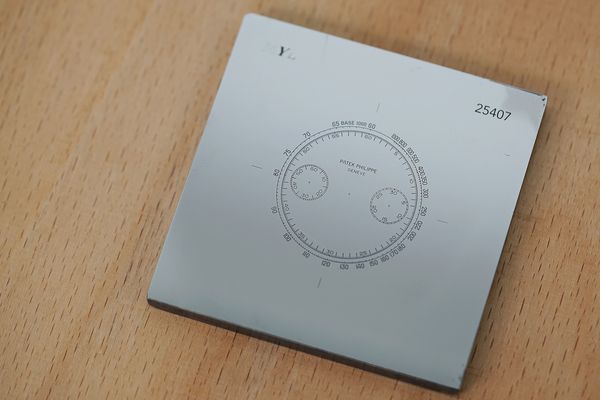
The Cadraniers de Genève used this Stern Frères stamp for the print transfers.
The indexes were taken off and the varnish removed, before making 120 individual print transfers to make the dial like-new, and finally applying a new varnish. The effort that's gone into returning this dial to its original state is unbelievable, really. Take the number -100- in the tachymeter scale. It was restored through three separate transfers, one for each number. All in all, the Cadraniers believe the project took 50 hours of careful labour.
"I'm very happy with the result," says the owner. "The watch looks great and the dial hasn't lost in authenticity. The alignment of the restored enamel inscriptions is so well done that you cannot tell that the dial has been retouched. It is in perfect harmony with its original state."
He believes the restoration has enhanced the watch's value, but he insists this is only because it was carried through by the very best and most knowledgeable craftsmen. "The result is down to the legitimacy of their work."
His watch is lot 284 of the upcoming Geneva Watch Auction: SEVEN, and has an estimate of CHF 200,000 to 300,000. For comparison's sake, the unrestored model, with Breguet numerals and Hausmann signed dial has an estimate of CHF 400,000 to 800,000. It will also be sold during the Geneva Watch Auction: SEVEN as lot 199.
